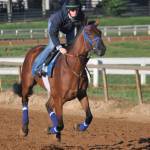Minimizing Stress for Young Horses in Race Training

Young Thorougbred horses spend a lot of free time in the pasture as foals, weanlings, and yearlings. As long yearlings (a few months before the end of their yearling year) or early two-year-olds, most are brought into a training program to begin their racing careers. This change of lifestyle is profound. The youngsters are usually moved from their initial location, stabled instead of pastured, introduced to a saddle and bridle, and exercised by being ridden on a training track.
To minimize stress while these changes are taking place, facilities at many racetracks are designed with roomy, well-ventilated stalls that allow the new arrivals to see and hear other horses, an important consideration for animals that have previously lived in a herd. The stalls are deeply bedded with straw, shavings, or another material that keeps the footing dry and encourages the horses to lie down when they want to. Water is always available, and hay nets are frequently hung in the stall doorway so that the horses can nibble while keeping an eye on the comings and goings of humans and other horses. The horses are groomed, bathed, handled from the ground, and ridden every day as they get used to the routine of training.
Each racetrack and training facility in the U.S. provides one or more types of training area or track. Some horses run better on dirt tracks while others excel on turf courses, and a trainer may have access to both types of surface as well as a course topped with weatherproof synthetic material that can be used in any season. Horses usually go to the training track early in the morning, especially in the summer months when daytime temperatures may rise into the triple digits. At some training centers, trainers can also use equine swimming pools, aquatic treadmills, and outdoor galloping lanes in addition to tracks of various lengths and surfaces.








